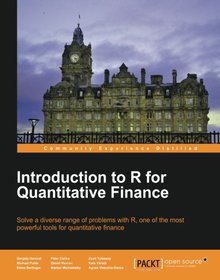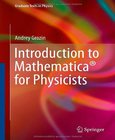Introduction to R for Quantitative Finance

Book Details:
| Publisher: | Packt Publishing |
| Series: | Packt |
| Author: | Edina Berlinger |
| Edition: | 1 |
| ISBN-10: | 178328093X |
| ISBN-13: | 9781783280933 |
| Pages: | 164 |
| Published: | Nov 22 2013 |
| Posted: | Nov 19 2014 |
| Language: | English |
| Book format: | |
| Book size: | 2.37 MB |
Book Description:
R is a statistical computing language that's ideal for answering quantitative finance questions. This book gives you both theory and practice, all in clear language with stacks of real-world examples. Ideal for R beginners or expert alike. Overview Use time series analysis to model and forecast house prices Estimate the term structure of interest rates using prices of government bonds Detect systemically important financial institutions by employing financial network analysis In Detail Introduction to R for Quantitative Finance will show you how to solve real-world quantitative finance problems using the statistical computing language R. The book covers diverse topics ranging from time series analysis to financial networks. Each chapter briefly presents the theory behind specific concepts and deals with solving a diverse range of problems using R with the help of practical examples. This book will be your guide on how to use and master R in order to solve real-world quantitative finance problems. This book covers the essentials of quantitative finance, taking you through a number of clear and practical examples in R that will not only help you to understand the theory, but how to effectively deal with your own real-life problems. Starting with time series analysis, you will also learn how to optimize portfolios and how asset pricing models work. The book then covers fixed income securities and derivatives like credit risk management. The last chapters of this book will also provide you with an overview of exciting topics like extreme values and network analysis in quantitative finance. What you will learn from this book How to model and forecast house prices and improve hedge ratios using cointegration and model volatility How to understand the theory behind portfolio selection and how it can be applied to real-world data How to utilize the Capital Asset Pricing Model and the Arbitrage Pricing Theory How to understand the basics of fixed income instruments You will discover how to use discrete- and continuous-time models for pricing derivative securities How to successfully work with credit default models and how to model correlated defaults using copulas How to understand the uses of the Extreme Value Theory in insurance and fi nance, model fitting, and risk measure calculation Approach This book is a tutorial guide for new users that aims to help you understand the basics of and become accomplished with the use of R for quantitative finance. Who this book is written for If you are looking to use R to solve problems in quantitative finance, then this book is for you. A basic knowledge of financial theory is assumed, but familiarity with R is not required. With a focus on using R to solve a wide range of issues, this book provides useful content for both the R beginner and more experience users.
Download Link:
Related Books:
F# for Quantitative Finance
An introductory guide to utilizing F# for quantitative finance leveraging the .NET platform Overview Learn functional programming with an easy-to-follow combination of theory and tutorials Build a complete automated trading system with the help of code snippets Use F# Interactive to perform exploratory development Leverage the .NET platform and other existing tools from Microsoft using F# In Detail F# is a functional programming language that allows you to write simple code for complex problems. Currently, it is most commonly used in the financial sector. Quantitative finance makes heavy use of mathematics to model various parts of finance in the real world. If you are interested in using F# for your day-to-day work or research in quantitative fina...
An Introduction to Excel for Civil Engineers
From Engineering Theory to Excel Practice
It's a Excel basics book that every civil engineer should have read by now. It addresses skills that may not be covered in most Excel for civil engineering texts, such as step by step guides to create an application program and how to convert the steps into VBA code, how to perform matrix operations (multiplication and inversion) using Excel-VBA, macro for creating an engineering chart, a brief and simple guide to become an instant Excel-VBA programmer, and more... Also to be presented the depiction in AutoCAD program. Yes! AutoCAD is chosen because one of its advantages that relies on high drawing accuracy. You will learn how to create a simple AutoCAD script file using Excel formulas and Excel-VBA. It is expected that you will be able to create sim...
Introduction to Mathematica for Physicists
The basics of computer algebra and the language of Mathematica are described. This title will lead toward an understanding of Mathematica that allows the reader to solve problems in physics, mathematics, and chemistry. Mathematica is the most widely used system for doing mathematical calculations by computer, including symbolic and numeric calculations and graphics. It is used in physics and other branches of science, in mathematics, education and many other areas. Many important results in physics would never be obtained without a wide use of computer algebra....
2007 - 2021 © eBooks-IT.org



